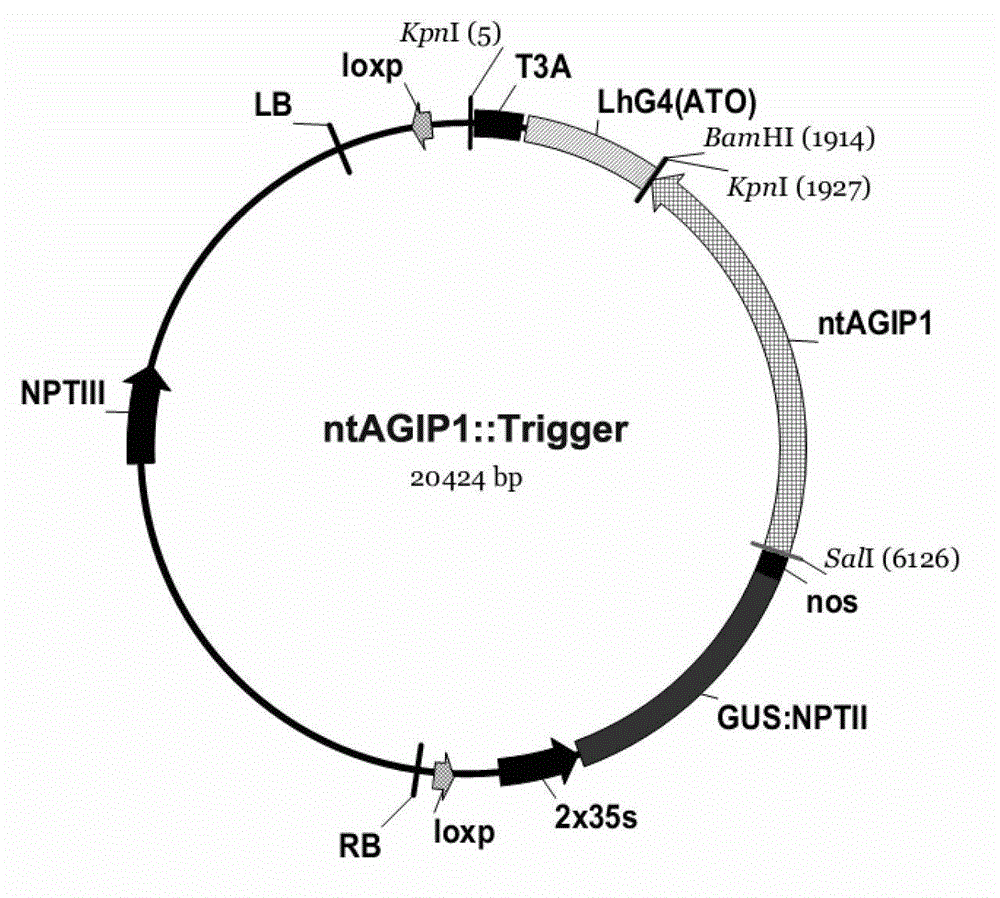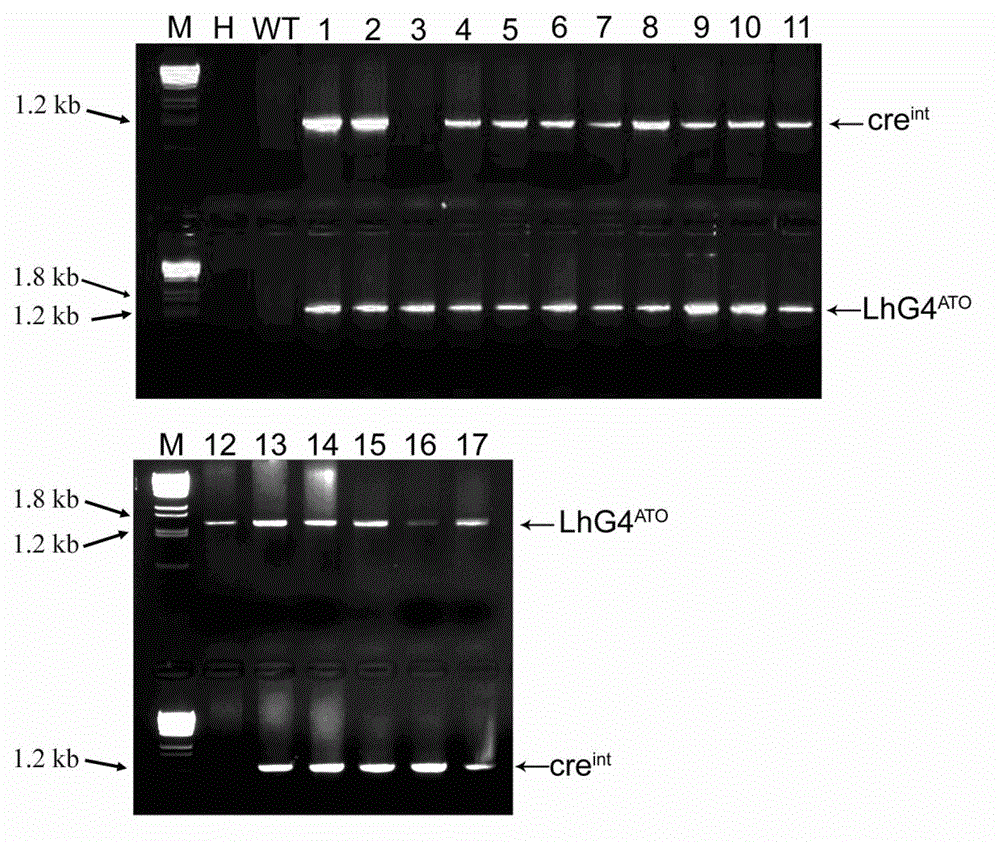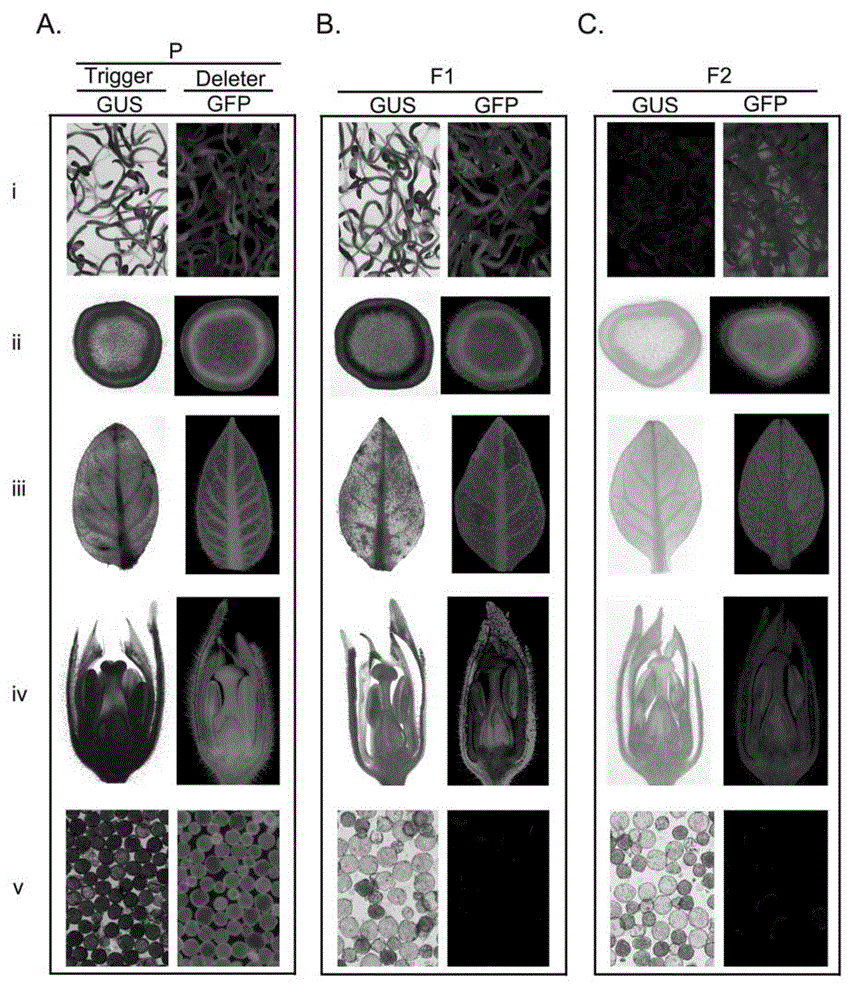Hybrid crop transgenic safety control method and gene deletion system for implementing same
A safety control and transgenic technology, applied in the field of plant genetic engineering, can solve problems such as unsolved problems
- Summary
- Abstract
- Description
- Claims
- Application Information
AI Technical Summary
Problems solved by technology
Method used
Image
Examples
Embodiment 1
[0032] [Example 1] Extraction of DNA and amplification of target fragment sequence
[0033] 1. Extraction of DNA
[0034] Select 0.3-0.5 g of young leaves of tobacco (Nicotiana tabacum, Xanthin), quickly grind them into a white powder in liquid nitrogen, transfer to a 10 mL centrifuge tube, add 3 mL of 65°C preheated DNA extraction buffer, shake and mix quickly. Water bath at 65°C for 45 minutes, during which time mixing 2-3 times. Then add 1mL 5mol / L KAc, ice bath for 20min. Extract once with an equal volume (4 mL) of chloroform:isoamyl alcohol (24:1) (10,000 r / min, centrifuge at 25°C for 10 min). Take the supernatant, add 2 / 3 times the volume of -20°C pre-cooled isopropanol, mix well, and let stand at room temperature for about 30 minutes. Pick out the flocculent precipitate, rinse twice with 75% ethanol, and rinse once with absolute ethanol. Blow dry at room temperature and resuspend in 600 μL TE. Add 1 μL RNaseA (10 mg / mL), and treat at 37°C for 1 hour to remove RNA i...
Embodiment 2
[0044] [Example 2] Construction of the Trigger plant expression vector of the flower primordium cell-specific promoter controlling the transcription activator gene
[0045] 1. Acquisition of plant flower primordia cell-specific promoters
[0046] According to the CaMV 35S minimal core promoter sequence on the plasmid pER8 (GenBank accession number: AF309825.2), primers (SEQ ID NO.1 and 2) were designed, and a sequence of about 600 bp was obtained by PCR amplification using the plasmid pER8 as a template. Sequencing results showed that the sequence was 602bp in length and contained a 58bp CaMV 35S (-46to+12) core promoter (minP for short), a multiple cloning site MCS and pea ribulose-1,5-bisphosphate carboxylase small The polyA sequence of subunit rbcS-3A gene (referred to as "T3A").
[0047] According to the second intron sequence of tobacco flower development AGAMOUS (AG) homologous gene 1 (GenBank accession number: GU143404.1), primers (SEQ ID NO.3, 4) were designed, and a ...
Embodiment 3
[0058] 【Example 3】Agrobacterium-mediated genetic transformation of tobacco
[0059] See Table 1 for the medium used for the genetic transformation of tobacco by the method mediated by Agrobacterium tumefaciens
[0060] Table 1: Medium for genetic transformation of tobacco mediated by Agrobacterium tumefaciens
[0061]
[0062] MS: Murashige & Skoog, 1962
[0063] B5: Gamborg, 1986
[0064] Agrobacterium-mediated introduction of leaf discs into tobacco. The specific method is as follows:
[0065] Tobacco seeds were sterilized with 1% sodium hypochlorite on solid medium MSB 0 The culture conditions were 25°C, 16hr light / 8hr dark photoperiod. After about one month, the sterile seedlings that grow vigorously can be used as transformed explants.
[0066] Select robust leaves, cut them into leaf discs of about 0.5 cm × 0.5 cm on a clean bench, and keep them moist for later use. Pick a single colony of Agrobacterium for transformation cultured on the YEB plate with a toothp...
PUM
 Login to View More
Login to View More Abstract
Description
Claims
Application Information
 Login to View More
Login to View More - R&D
- Intellectual Property
- Life Sciences
- Materials
- Tech Scout
- Unparalleled Data Quality
- Higher Quality Content
- 60% Fewer Hallucinations
Browse by: Latest US Patents, China's latest patents, Technical Efficacy Thesaurus, Application Domain, Technology Topic, Popular Technical Reports.
© 2025 PatSnap. All rights reserved.Legal|Privacy policy|Modern Slavery Act Transparency Statement|Sitemap|About US| Contact US: help@patsnap.com



